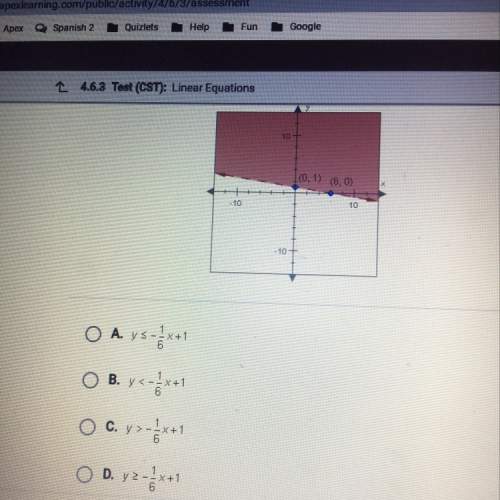
Mathematics, 15.12.2020 01:00, neash19
Ankur estimated the quotient of 15 and one-third divided by (negative 4 and two-thirds) to be 3. Which best describes his error?
A. Ankur multiplied the compatible numbers 15 and –3.
B. Ankur found that the quotient of a positive number and a negative number is negative.
C. Ankur found that the quotient of a positive number and a negative number is positive.
D. Ankur added the compatible numbers 15 and –3.

Answers: 2
Other questions on the subject: Mathematics

Mathematics, 21.06.2019 13:40, harleyy6802
What is the correlation coefficient for the data? don't forget to turn the diagnoisticon (in the catalog menu of the calculator). r = answer (round to the nearest thousandth)
Answers: 1

Mathematics, 22.06.2019 01:20, ramenbowlz
Do one of the following, as appropriate: (a) find the critical value z subscript alpha divided by 2 , (b) find the critical value t subscript alpha divided by 2 . 99%; nequals 17; sigma is unknown; population appears to be normally distributed.
Answers: 3

Mathematics, 22.06.2019 02:00, arlabbe0606
(30 points). the population of a city is 45,000 and decreases 2% each year. if the trend continues, what will the population be aer 15 yrs
Answers: 2

Mathematics, 22.06.2019 04:00, brookieharrisop5n7us
Me! i'm really confused the isosceles trapezoids, abcd and efgh, are similar quadrilaterals. the scale factor between the trapezoids is 2: 3, line gh = 6 centimeters, line ad = 8 centimeters, and line ab is three times the length of line dc . use complete sentences to answer the following prompts and include all of your calculations in your final answer. a. write a similarity statement for each of the four pair of corresponding sides. b. write a congruence statement for each of the four pair of corresponding angles. c. determine the perimeter for each of the isosceles trapezoids.
Answers: 2
Do you know the correct answer?
Ankur estimated the quotient of 15 and one-third divided by (negative 4 and two-thirds) to be 3. Whi...
Questions in other subjects:



Mathematics, 21.09.2019 11:10

English, 21.09.2019 11:10



Mathematics, 21.09.2019 11:10


Mathematics, 21.09.2019 11:10

Mathematics, 21.09.2019 11:10







